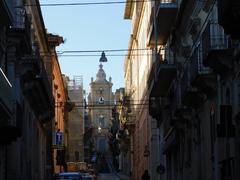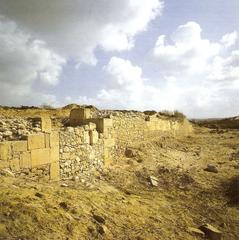San Giacomo Apostolo Ragusa: Visiting Hours, Tickets, and Travel Guide
Date: 14/06/2025
Introduction
San Giacomo Apostolo, set within the tranquil Giardino Ibleo in Ragusa Ibla, is a remarkable testament to Sicily’s layered history, architectural evolution, and enduring faith. With origins tracing back to the late 13th or early 14th century, the church stands as a witness to both medieval devotion and the Baroque transformations that followed the catastrophic 1693 earthquake. Today, it offers visitors an immersive journey through centuries of artistic, religious, and cultural heritage (theworldofsicily.com; Go Ask a Local).
This comprehensive guide provides essential information about San Giacomo Apostolo’s history, art, visiting hours, ticketing, accessibility, and tips to help you make the most of your visit to one of Ragusa’s most treasured sites (Ragusa Oggi; Comune di Ragusa).
Table of Contents
- Historical Overview
- Architectural Evolution
- Artistic Treasures and Interior Features
- Religious and Cultural Significance
- Visiting Information: Hours, Tickets, Accessibility
- Location and Nearby Attractions
- Special Events and Guided Tours
- FAQs
- Preservation and UNESCO Status
- Conclusion
- References
Historical Overview
San Giacomo Apostolo’s history begins in medieval Ragusa, likely constructed atop the ruins of a Roman temple dedicated to Lucina, the goddess of childbirth. Its original layout featured three naves, reflecting the liturgical and social customs of the era. The church’s patronage by the Chiaramonte family and the presence of the Aragonese eagle above the altar symbolize its medieval Sicilian roots (Italyscapes).
The 1693 earthquake devastated Ragusa and much of southeastern Sicily, destroying the church’s lateral naves and prompting a major Baroque reconstruction. The rebuilding effort was not just architectural but deeply communal, intertwining faith and resilience. Elements salvaged from the destroyed Church of San Teodoro were incorporated into the new structure, preserving a tangible link to Ragusa’s pre-Baroque heritage (Quotidiano di Ragusa).
Architectural Evolution
Medieval Foundations and Baroque Transformation
The church’s transition from a medieval three-nave basilica to a single-nave Baroque church mirrors the broader architectural revival seen throughout Ragusa and the Val di Noto after the earthquake (Eternal Arrival). The early 18th-century restoration added artistic flourishes, with the wooden roof completed in 1705 and adorned by Simone Ventura in 1734.
The 1902 Facade
Completed by architect Giuseppe Pinelli, the 1902 facade is a quintessential example of Sicilian Baroque with eclectic influences:
- Lower Order: Main entrance portal with Corinthian columns.
- Middle Order: Decorative window with a lunette.
- Upper Order: Bell tower with balustrade and sculptural groups, including St. George the Knight, St. James, and St. John the Evangelist (Comune di Ragusa; Italyscapes).
The facade’s statuary and bas-relief depict St. James both as a soldier and as a pilgrim, reflecting his spiritual and cultural significance.
Artistic Treasures and Interior Features
Inside, San Giacomo Apostolo is a repository of sacred art:
- Chapels and Altars: Ten side chapels house devotional artworks and altars.
- Wooden Statue of St. James: A focal point for worship and artistry.
- 16th-century Wooden Crucifix: Surviving from the pre-earthquake period.
- 1888 Pipe Organ: Still used for liturgical music.
- Gothic-style Confessional: Carved with enduring medieval motifs.
- Stone Eagle at Altar: Symbolizing Norman influence and the Chiaramonte patronage.
- Decorated Wooden Ceiling: Painted by Matteo Battaglia (1754), gilded by Giovanni Cannì (1786), featuring the four Evangelists and other saints.
Elements from the destroyed church of San Teodoro are integrated throughout, adding layers of historical resonance (Quotidiano di Ragusa).
Religious and Cultural Significance
San Giacomo Apostolo is not only an architectural gem but also an active parish at the heart of Ragusa’s spiritual life. The church is central to the annual feast of St. James (July 25th), featuring processions, liturgies, and traditional celebrations that unite the community. It is part of the broader network of pilgrimage sites dedicated to St. James and stands as a focal point for local devotion and cultural identity (Diocese of Ragusa; Go Ask a Local).
Visiting Information: Hours, Tickets, Accessibility
Opening Hours
- Monday to Saturday: 9:00 AM – 1:00 PM, 3:00 PM – 6:30 PM
- Sunday and Holidays: 10:00 AM – 12:30 PM, 4:00 PM – 7:00 PM
(Hours may vary during religious festivals and special events. Always check ahead.)
Tickets
- Admission: Free of charge. Donations are appreciated and support ongoing maintenance.
Accessibility
- Wheelchair Access: Ramps are available at the main entrance. Some interior areas have uneven floors due to the church’s historic character.
- Visitor Assistance: Available upon request.
Location and Nearby Attractions
San Giacomo Apostolo is located within the scenic Giardino Ibleo, Piazza G. B. Odierna, Ragusa Ibla. The garden itself is a destination, offering shaded paths, fountains, and panoramic views.
Nearby attractions:
- Duomo di San Giorgio: Ragusa’s most prominent Baroque cathedral.
- Chiesa di San Giuseppe: Another Baroque masterpiece.
- Palazzo Arezzo di Trifiletti: Historic palace with guided tours.
The area is pedestrian-friendly, and parking is available nearby. Local buses connect Ragusa’s modern and historic centers.
Special Events and Guided Tours
- Feast of St. James (July 25th): Processions, religious services, and community festivities.
- Guided Tours: Can be arranged through local tourism offices or private guides. Audio guides are also available for rent.
- Photography: Allowed for personal use; filming requires permission.
FAQs
Q: What are the church’s visiting hours?
A: Monday to Saturday: 9:00 AM–1:00 PM and 3:00 PM–6:30 PM; Sunday and holidays: 10:00 AM–12:30 PM and 4:00 PM–7:00 PM. Hours may vary during special events.
Q: Is admission free?
A: Yes, entry is free. Donations are welcome.
Q: Is the church accessible to visitors with disabilities?
A: Yes, via ramps at the main entrance. Some interior spaces may be less accessible due to the historic structure.
Q: Are guided tours available?
A: Yes, through local tourism offices or by pre-arrangement with guides.
Q: Can I take photographs inside?
A: Photography is permitted for personal use, but avoid using flash or disrupting services.
Q: Is there parking nearby?
A: Yes, parking is available near Ragusa Ibla. The old town is best explored on foot.
Preservation and UNESCO Status
San Giacomo Apostolo is part of the UNESCO World Heritage-listed Baroque towns of Val di Noto, underscoring its international significance and the importance of ongoing preservation efforts (UNESCO). Restoration initiatives have focused on structural stability and conservation of artistic elements, ensuring the church remains a vibrant part of Ragusa’s cultural landscape (Ragusa Oggi).
Conclusion
San Giacomo Apostolo is a living monument reflecting the resilience, artistry, and devotion of Ragusa across centuries. Its blend of medieval origins, Baroque splendor, and active community life makes it a must-visit site for anyone exploring Sicily’s rich heritage. Whether you’re admiring its ornate facade, exploring historic chapels, or experiencing local traditions during the feast of St. James, the church offers inspiration and insight into the heart of Ragusa.
For the latest visiting details, guided tours, and cultural updates, download the Audiala app and consult local tourism offices. Enhance your journey with audio guides, maps, and real-time event notifications to make the most of your Ragusa experience.
References and Further Reading
- theworldofsicily.com
- Go Ask a Local
- Comune di Ragusa
- Ragusa Oggi
- UNESCO
- Diocese of Ragusa
- Italyscapes
- Quotidiano di Ragusa
- Eternal Arrival
- PlanetWare

